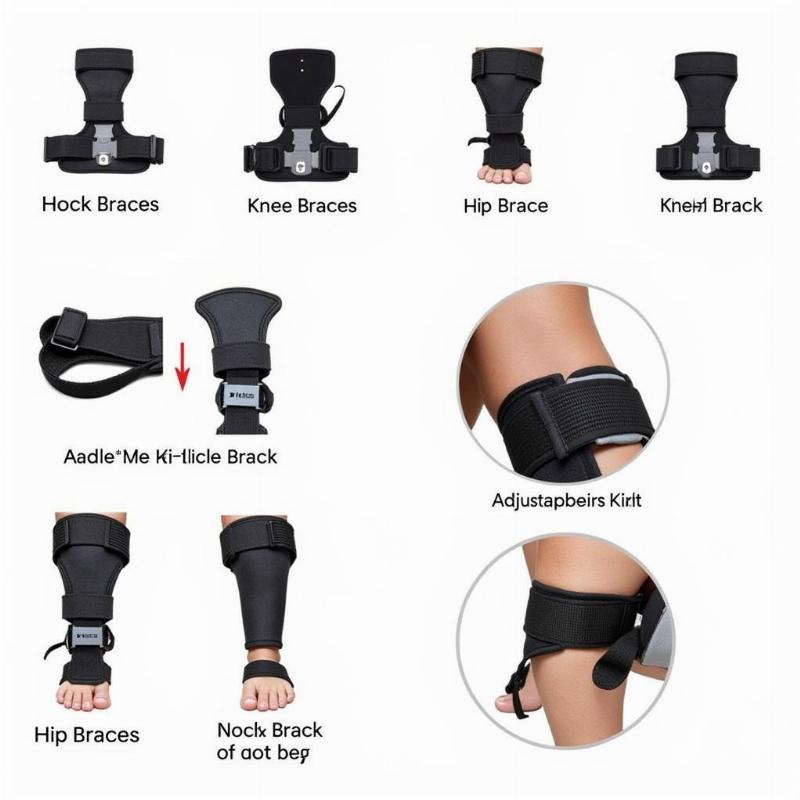A dog brace for the back leg can be a lifesaver for your furry friend struggling with mobility issues. Whether it’s due to injury, arthritis, or a neurological condition, a properly fitted brace can provide support, stability, and pain relief, allowing your dog to enjoy a more active and comfortable life. This guide will navigate you through everything you need to know about dog braces for back legs, from understanding their function and choosing the right type to proper fitting and aftercare in the US market.
Understanding the Need for a Dog Brace for Back Leg
When a dog experiences weakness or instability in their back leg, it can significantly impact their quality of life. Simple tasks like walking, standing, and even playing can become challenging and painful. A back leg brace works by providing external support to the affected limb, stabilizing the joint, and reducing strain on surrounding muscles and tendons. This can alleviate pain, improve mobility, and prevent further injury. There are a variety of reasons why your dog might need a back leg brace, including:
- Cruciate Ligament Injuries: These are common knee injuries in dogs, often requiring surgery. A brace can be used pre- or post-operatively to support the joint and promote healing.
- Arthritis: This degenerative joint disease can cause pain and stiffness in the legs, making movement difficult. A brace can help reduce inflammation and improve mobility.
- Hip Dysplasia: This genetic condition affects the hip joint and can lead to pain and lameness. A brace can offer support and stability to the affected leg.
- Neurological Conditions: Certain neurological conditions can cause weakness or paralysis in the hind limbs. A brace can provide support and help maintain proper posture.
- Post-Surgical Recovery: Following surgery on the back leg, a brace can aid in the healing process and prevent re-injury.
 Different Types of Dog Back Leg Braces
Different Types of Dog Back Leg Braces
Choosing the Right Dog Brace for Back Leg
Selecting the correct brace is crucial for its effectiveness. Different types of braces are designed for specific conditions and areas of the leg. Here’s a breakdown of the common types:
- Hock Braces: These braces support the lower portion of the back leg, including the ankle and hock joint.
- Knee Braces: Specifically designed for the knee joint, these braces are often used for cruciate ligament injuries.
- Hip Braces: These braces provide support to the hip joint and surrounding muscles.
Consulting with your veterinarian is essential to determine the most appropriate type of brace for your dog’s individual needs. They can assess your dog’s condition, recommend the right level of support, and ensure a proper fit.
Proper Fitting and Care of Your Dog’s Back Leg Brace
A well-fitted brace is crucial for comfort and effectiveness. Follow these tips for proper fitting:
- Professional Measurement: Your veterinarian or a trained professional should take precise measurements of your dog’s leg to ensure the brace fits correctly.
- Gradual Introduction: Introduce the brace gradually, allowing your dog to adjust to the feeling of wearing it.
- Regular Monitoring: Check the brace regularly for any signs of wear and tear, and ensure it continues to fit properly as your dog recovers.
Living with a Dog Back Leg Brace
Integrating a brace into your dog’s life requires patience and understanding. Here are some key considerations:
- Activity Modification: Adjust your dog’s activity levels based on their comfort and the veterinarian’s recommendations.
- Physical Therapy: Combining brace usage with physical therapy can help strengthen muscles and improve mobility.
- Regular Veterinary Checkups: Regular checkups are important to monitor your dog’s progress and address any potential issues.
Where to Buy a Dog Brace for Back Leg in the US
Several reputable suppliers in the US offer high-quality dog braces. Look for brands known for their durability, comfort, and effective support. Researching online retailers and comparing prices can help you find the best option for your budget.
Conclusion
A dog brace for the back leg can significantly improve your dog’s quality of life by providing support, stability, and pain relief. By understanding the different types of braces, ensuring a proper fit, and following appropriate care guidelines, you can help your furry friend regain mobility and enjoy a more comfortable and active life. Remember to consult with your veterinarian for personalized advice and recommendations.
FAQ
- How long will my dog need to wear the brace?
- Can my dog sleep with the brace on?
- How do I clean the brace?
- What are the signs that the brace doesn’t fit properly?
- How can I encourage my dog to accept the brace?
- What exercises can I do with my dog while they are wearing a brace?
- Are there alternatives to a brace for back leg issues?
Further Reading on Beautdogs.us
- Canine Arthritis: Understanding the Signs and Treatment Options
- Cruciate Ligament Injuries in Dogs: A Guide for Pet Owners
- Hip Dysplasia in Dogs: Prevention, Diagnosis, and Management
Beautdogs.us is your trusted source for comprehensive dog care information in the US. We provide expert guidance on various dog breeds, from common to rare, alongside in-depth knowledge on health care, nutrition, and training. Our platform offers practical advice on responsible pet ownership, including legal aspects and financial planning. We also review and recommend quality pet products, from food to grooming supplies. Whether you’re a new dog owner or a seasoned one, Beautdogs.us is your go-to destination for all things canine. When you need assistance, feel free to reach out via Email: [email protected] for detailed and accurate answers.